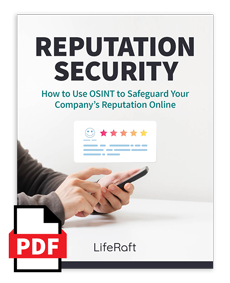Your company works hard to secure your brand's reputation and maintain your status as a business that consumers can trust.
97% of consumers search online for reviews of your company before making a connection, so ensuring that your company has a solid online brand protection strategy in social media channels and all other online forums is essential.
According to a survey conducted by the World Economic Forum (which included 1,500 participants), three-fifths of company executives stated that corporate brand or reputation represented more than 40% of a company’s market capitalization. The survey results mean that consumer trust is the cornerstone of conducting business and ensuring long-term growth.
The problem is that as your company and your brand recognition grow, so do potential online threats.
Bad actors are prevalent worldwide, with malicious intent to deceive customers and take advantage of your legitimate brand for their purposes.
Failure to adequately capitalize on brand protection solutions can impact your brand's revenue. Unauthorized sellers and unfair competition can divert profit from your business. It can also damage a brand’s reputation, resulting in unknown costs. As such, online brand protection solutions should be an important goal for your security, customer service, and marketing teams.
With billions of channels where misinformation can spread, how can you foster brand protection online? What is an ideal brand protection strategy your company can implement, and how can you quickly identify these bad actors and online or in-person threats before they become a crisis?
It starts with understanding the fundamentals of online brand protection.
Learn More: How to Use OSINT to Safeguard Your Company’s Reputation Online
What is Online Brand Protection?
Online brand protection is safeguarding a company’s legitimate brand against bad actors who seek to profit in some way from a brand’s intellectual property (IP), including its domain names, trademarks, designs, patents, and other fundamental components of a company’s brand.

Protecting your brand against potential brand abuse involves far-reaching online brand protection solutions, ranging from anti-counterfeiting measures to investing in specialist software solutions.Brand protection strategy utilizes advanced technology to scour the entire internet — including social media accounts, online platforms, online marketplaces, and illegitimate or fake websites — to find potential brand impersonations or cases of brand abuse.
Why is it important to have online brand protection?
Brand protection is essential to protect your unsuspecting customers, your company’s reputation, and – in turn – your profitability. Without extensive brand protection, you risk data breaches, losing income due to counterfeit products, reputational damage on social media platforms, and other distribution channels where reviews and information flow freely.
Simply put, brand protection safeguards your customers, but it also protects your bottom line and your market share. With millions of internet users acting in bad faith, a brand protection strategy is all but required for every company to protect its authentic brand.
What is Brand Abuse?
 Brand abuse refers to a third party exploiting a brand’s intellectual property for financial or personal gain. There are multiple ways that bad actors achieve brand abuse, which include the following activities:
Brand abuse refers to a third party exploiting a brand’s intellectual property for financial or personal gain. There are multiple ways that bad actors achieve brand abuse, which include the following activities:
Counterfeiting
This involves manufacturing and selling knockoff products or counterfeit goods that may resemble your brand's products but lack quality. Counterfeiting can use multiple channels, like social media platforms, imitation sites, or e-commerce platforms, to sell these consumer goods and counterfeit products.
The result? Damage to your authentic brand through shoddy merchandise or services.
Counterfeiting can negatively impact both your company's revenue and reputation. The two primary ways to protect your brand from counterfeits are through litigation and enforcement of counterfeit listings. Initiating litigation requires a cost-benefit analysis. While courts can grant an order to stop all infringements, litigation is often costly, time-consuming, and only sometimes successful. Meanwhile, the damage done to your brand while the litigation is ongoing may be irreparable.
An alternative to litigation is to enforce the counterfeit listings. The process varies depending on the platform where the infringement occurs. Generally, social media networks and e-commerce platforms are aware of the problem and support the enforcement process.
Copyright infringement
Copyright infringement, also referred to as copyright piracy, consists of the unauthorized use, reproduction, distribution, or display of intellectual property as protected by copyright intellectual property law. On commerce sites, infringing listings are those that display the trademarks or legitimate brands without authorization. (The US Copyright Office has a long list of guidelines that outline these IP protections and topics, such as IP infringement and IP rights for established companies and their brands.)
Infringing websites and social media accounts
Bad actors often create fake websites and social media accounts to infringe the IP rights of an established brand as a form of brand abuse.
These IP infringements can take many forms that can affect a brand, which includes the following:
- Cybersquatting – Cybersquatting refers to registering or buying domain names replicating existing brands' names. From there, domain owners offer the domain names for sale to the person or company who owns the trademark or intellectual property rights at a high price.
- Typosquatting – Typosquatting involves enlisting a domain name that closely resembles the domain name of an existing brand to direct unsuspecting customers to a different URL. From there, customers are directed to counterfeit online marketplaces or e-commerce sites. Alternately, bad actors obtain a customer's sensitive data, such as username, password, social security number, and other information that can lead to costly data breaches for the brand and the consumer.
- Imitation websites and social media accounts – Like typosquatting, imitation websites, and accounts entail social media channels that mimic an existing brand for illicit purposes.
- Gray Market Selling – Technically not illegal in the United States and beyond, gray market selling involves the sale of authentic goods from a legitimate brand through unauthorized channels. Gray market selling also referred to as parallel import, can result from unavailable authentic goods due to supply chain issues. Still, it can also correlate with other market situations, such as price differences between distributors or countries worldwide.
How Brand Abuse can affect your Company’s Brand and your Bottom Line
Bear in mind that the above list is just the tip of the iceberg when it comes to brand abuse methodology, and once a company has been the target of brand abuse, there are several potential pitfalls:
- Loss of revenue – As mentioned previously, counterfeit products sold on e-commerce sites or in person can directly impact your bottom line, as your company loses sales due to similar but inferior products flooding the marketplace.
- Bad reputation with consumers – Whether bad actors utilize intellectual property infringements for financial gain or to sour your brand’s image, your brand’s reputation will suffer. Customers may no longer trust your company, and the loss of income due to a misperception of your company is impossible to calculate.
- Downtime and loss of resources – Many brands need more resources to engage in online brand protection or launch anti-counterfeiting measures proactively. Therefore, when brand abuse occurs, the cost to fight counterfeiting and other forms of brand abuse can result in downtime and a loss in productivity across the board.
What is a Brand Protection Strategy?

A brand protection strategy is an all-encompassing endeavor to protect your brand through multiple actions and continuous monitoring. From online brand protection to effective enforcement measures, brand protection solutions are multi-faceted and require several steps and moving parts to implement them successfully.
What does a Brand Protection Strategy Entail?
While the details of a brand protection solution are specific to every industry and company, a few broad actions are essential to any brand protection strategy.
- Ensure you have taken legal steps to protect your brand. The first step to successfully protect your brand against IP infringers is registering your brands' names and logos as trademarks and producing all of your products or services with design and utility patents.
- Ensure partner compliance. If you work with other partners or vendors selling your products or services, ensure they comply with your specific brand identity.
- Ensure IP protection across multiple platforms. From malicious bots to independent bad actors, there are potential threats to your brand’s reputation from every corner of the internet. To safeguard your intellectual property, you must ensure your brand online is authentic and well-represented. This approach entails scouring different websites, investigating social media channels, online forums, dark web sites, mobile apps, and many other sites and channels where misinformation can flourish.
What Platforms Require Online Brand Protection?
Websites, social media, marketplaces, and search engines are all virtual platforms that require attention to ensure the integrity of your online presence:
- Social media – Social media has become an increasingly important tool for brands to reach and connect with their desired audiences. Consequently, brands must protect their social media presence with regular monitoring and strategic content curation. Without proper protection, social media networks are susceptible to impersonators, slander, and inaccurate or flat-out false information presented as an official approved source from the brand. Your business must take advantage of social media while also using proactive measures to protect both your messages and images across social media platforms. Doing so will preserve your company's credibility and maintain the trust between your brand, customers, partners, suppliers, and agencies.
- Search engines – Search engines require brand protection to reduce the risk of miscellaneous or fraudulent activity damaging companies' reputations and online presence. It also allows search engine providers to filter out search results and provide users with trustworthy content, helping them find accurate information more efficiently. Search engines like Google play an unwitting role in the problem of fraudulent search results. Using “malvertising,” fraudulent advertisers pay for prime placement on engines like Google and Bing. While Google has taken measures to reduce fraudulent listings through stricter policies, it has not been able to eradicate the problem. Brand protection is an important step that search engines need to take to maintain relevancy and trust amongst their users.
- Marketplaces – Marketplaces have become an integral part of our e-commerce landscape, offering resources and services to customers, large and small. As marketplaces have grown in size, it is clear that protecting customer trust and brands operating within these marketplaces is more crucial than ever. With solid brand protection measures, marketplaces can avoid potentially disastrous financial losses due to counterfeiting, warranty issues, fraudulent activity, and trademark infringements.
What are Brand Protection Services, and what do Brand Protection Companies Offer?
Your company, regardless of size, needs more resources to conduct 24/7 online brand protection monitoring. Because a company's brand and public relations are inextricably linked, this endeavor often falls on your marketing and customer relations teams.
The issue with conducting online brand protection strategies in-house is that security teams can miss information. Anti-counterfeiting measures need to be far-reaching when it comes to protecting your income and reputation. Your best bet is to partner with a brand protection company to achieve maximum protection.
Brand protection companies are the best resource to fight counterfeits and other issues. Their sole purpose is to filter through limitless and ever-changing information to identify threats to your brand. Many brands and companies of all sizes outsource their brand protection solutions simply because the expertise and work involved require a specialist that can cover all of the intricate aspects of brand protection.
How Brand Protection Services Can Help
Brand protection tools perform a long list of continuous functions to protect your brand, and a sample of these services includes the following:
- Technologically advanced solutions – Brand protection companies use various technologically advanced tools to protect your brand, such as machine learning, conducting test purchases, and automating data collection and filtering to comb through limitless information related to your brand.
- Automation to ensure faster and more comprehensive protection – Finding the needle in the haystack is a growing challenge for brand protection. However, modern brand protection platforms like Navigator utilize automation to monitor the internet 24/7 for any potential risks.
- Comprehensive monitoring for all possible threats to your brand – The most advanced brand protection services goes miles outside of search engines or social media channels to identify dangers lurking in the darker and less-discovered corners of the internet. These diversified sources include blogs and forms, alternative social media channels, classified and paste sides, deep web sites, and dark web sources. Ultimately, when it comes to a brand's reputation, these lesser-known channels are often the frontlines of a more significant brand crisis.
- Fast alerts and reporting – When it comes to threats to your brand, timing is everything, and advanced tools like LifeRaft's Navigator use multiple types of alerts concerning events, assets, or operations that might hurt your brand’s reputation. With this reporting, your company can make data-driven decisions in all aspects of your marketing and other functions and can protect your brand continuously before an emergency floats to the surface.
Protect your brand with the proper online brand protection with LifeRaft
As your company grows and gains visibility in the global sphere of the internet, the need to protect your brand also grows.
Customer engagement and loyalty are imperative to maintain your business, and if your brand is subject to counterfeiting, IP infringement, or misinformation, every aspect of your operations suffers.
But when it comes to brand protection, you don’t have to go it alone.
At LifeRaft, we offer the most comprehensive tool to protect your brand in all areas. Our unified intelligence platform, Navigator, automates data points collection, and filtering and features investigative tools that explore and validate threats across the board. With Navigator, you can detect the critical information that impacts the security of your brand, assets, and operations. Whether it's your company's reputation as a whole, the manufacturing of substandard products designed to mimic your company's offerings, or even the reputation of your CEO or executive team, Navigator can help.
As of January 2023, there were 5.16 billion internet users worldwide (or 64.4% of the world’s population), which means that the potential threats to your brand are vast. By partnering with an elevated and advanced platform like Navigator, you can ensure that you have the resources to protect your company and your brand, regardless of the specific threats to your ability to conduct business.
Contact us today, and let’s start a conversation about crafting an individualized brand protection strategy to ensure your company maintains and grows its stellar reputation online in the everyday world.

